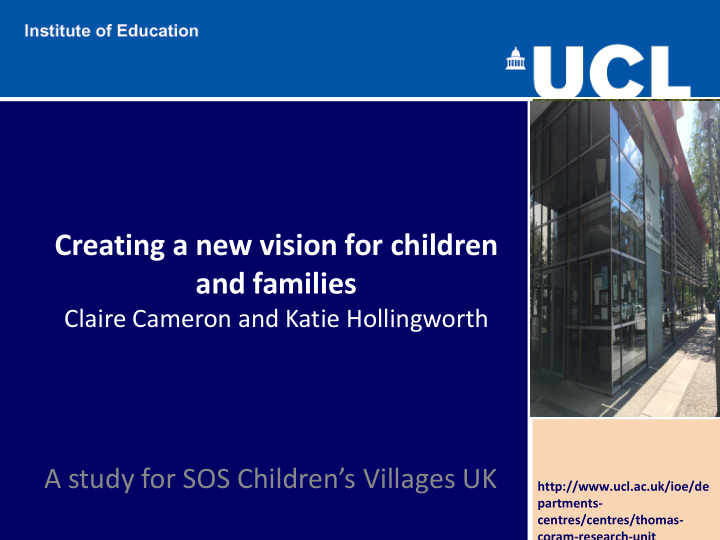



Creating a new vision for children and families Claire Cameron and Katie Hollingworth A study for SOS Children’s Villages UK http://www.ucl.ac.uk/ioe/de partments- centres/centres/thomas- coram-research-unit
Aims • What are the issues and where are the gaps for children and families’ services today • What could services look like? • What conditions are needed for change?
Key issues • Large numbers of children living in difficult circumstances in the UK (estimated at 2 million) • Increasing: rate of referrals to Children’s Services; numbers of children assessed as being ‘a child in need of help or protection’ (particularly adolescents); numbers of looked after children (particularly aged 10-15 years and 16+) • A fragmented system, struggling to meet the increased demands at all stages, from early help through to LAC • Increasing strain on resources, cuts/real terms reduction in money received from Gov, resulting focus on those at serious risk or who have already suffered harm (“fire - fighting”/reactive services) at the expense of early intervention and support for children and families? • Quality and effectiveness of early help services is highly variable and provision is patchy • Declining capacity of the foster care system and the residential care system? • Inconsistency in availability and variable quality of support and services to children in residential and foster care, and to support those caring for them in these placements. Financial constraints on the provision and capacity of such wider support
SOS Children’s Villages • Family upbringing for every child • Supporting vulnerable children and fragmented families in 135 countries worldwide • Alternative care – the SOS parent • Family strengthening programmes
Berlin – Moabit - multi-generational house • Meeting needs of diverse community - integration • Café • Family education • Kindergarten • Children’s home + after care = upbringing • Counselling/psychotherapy • Neighbourhood engagement • Volunteers as ‘mediators’
Helsinki – a traditional ‘village’ 4-6 children with SOS parents An ordinary upbringing in an ordinary community Specialist support on site e.g, detective club Care leavers welcomed home
More flexible provision? • Integrated planned respite and family support • Foster carers with nearby and extensive support • Meeting needs in communities – family strengthening • Early intervention & multi-disciplinary working Upbringing … integration … solidarity
Your vision • What was attractive in the two examples? • What do we need to better support families with their parenting? • What strategic thinking or organising concepts would support your vision?
Residential respite • DfE Innovation funding (£200 million) dedicated to residential care for development of ‘more dynamic and creative ways of supporting children and young people’ • Potential for fluid use of residential respite alongside integrated intensive work with young people and their families to provide a more flexible approach to supporting adolescents in need/at risk – “provide an innovative and creative approach to providing planned relief from the difficulties that lead to family breakdown, whilst facilitating work with adolescents and their parents in the home environment….. such integrated respite and family support models might offer potential for diffusing crises, dissipating difficulties and enabling young people to remain, where safe to do so, with their families” (Dixon et al 2015 ) • Residential respite for children and young people at risk of entering care far more common in continental Europe, includes: – Weekday only provision with parents visiting during the week to take part in therapeutic family work with child, the child then goes home with the parents at weekends – Boarding school provision – Emergency accommodation with counselling for children/young people • Research indicates that residential respite can be a “ beneficial option within a wider framework of support and broad menu of options ” (Boddy et al, 2009) • Residential respite in the UK: research has indicated positive outcomes e.g. diversion from entering care, strengthening family relationships, reduction of risk
Ealing Innovation model of support for edge of care and in-care young people • Multi-disciplinary teams with a range of specialist expertise; immediacy of intervention work, reduced need for referrals, no waiting lists • ‘Lead worker’: intensive contact/support, consistency • Lower caseloads; more time for direct contact/work and more in- depth, holistic support • Early identification of emerging issues and early intervention • Lower staff turnover; consistency of care and relationships • More positive relationships between professionals and those they support • ‘Team around the worker’; strong collaborative team approach, shared case responsibility
1. Etelä-Suomi (Southern Finland) • Espoo Tapiola (1966), Niittykumpu • CV-families • 2 Niittykumpu (8 children, 4-13 years) • 1 Tapiola (6 , 6-15 years) • 1 Nastola (5 adol.) • Fosterfamilies • 2 Niittykumpu (7) • Youth support • After care (aged 18-21) • Supported living (up to 21) • Day activity: The RHYTMH • Vantaa Kivistö (2017) • Fosterfamilies (2 in summer 2017, + 2018 2 as) • Family rehabilitation (4 apartments) • Espoo perheryhmä- tukiasumiskoti (2015, 2017) • Lone minor refugees • Group home (14, 13-16 years.) • Assisted home (5, 16+) • Independent living (1)
Recommend
More recommend